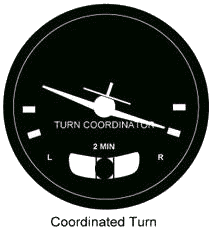Turn coordinator


The turn coordinator is an aircraft instrument which displays to a pilot information about the rate of yaw (turn), rate of roll, and the 'quality' or 'coordination' of the turn. The turn coordinator was developed to replace the older turn and bank indicator, which displayed rate and quality of turn but not rate of yaw. The initial reason for the development of the TC was to create a single instrument that could be used by an autopilot to control the roll axis of an airplane. Due to the "newer" look the same instrument without autopilot sensing became popular in small general aviation airplanes but rarely if ever appeared in jets or large airplanes. The general idea of turn coordination on the indicator is to keep the indicator ball in the center of the inclinometer. Too much or too little yaw correction is known as a skid or a slip, respectively. Because yaw is controlled by the rudder, and the rudder by the rudder pedals, the phrase "step on the ball" is sometimes used to enforce the idea of coordinating yaw axis with the roll.
The turn coordinator is, like the turn and bank instrument it replaced, a gyroscopic instrument. An internal gyroscope, typically electrically driven, spins at approximately 20,000 rpm with the spin axis perpendicular to the longitudinal axis of the airplane and the free axis tilted up 30 degrees from it. As the aircraft rotates about the yaw or roll axis, the principle of gyroscopic inertia causes the gyro to "resist" the change in its rotational axis about the free axis. This resisting force works against a spring; thus, a slow rate of turn deflects the gyro slightly while a higher rate of roll or yaw deflects it more. The gyroscope's movements are linked to an indicator on the front face of the turn coordinator.
The indicator looks like a little airplane seen from behind: when the airplane is level, the rate of yaw plus the rate of roll is zero; when it is tilted, the amount and direction of tilt show the pilot the rate of turn plus the rate of roll. The wings of the symbolic airplane line up on white tick marks at the level position to indicate zero rate of turn. There is another set of tick marks below the level pair. When the symbolic aircraft is tilted so as to align with one of the tick marks (and the airplane is in a constant bank), the aircraft is said to be turning at standard rate of turn, which is 3 degrees of heading change per second. This is often marked on the face plate of the instrument as '2 minutes', since it takes two minutes to complete a 360° heading change when turning at 3°/s.
The quality of turn is indicated by an inclinometer. This is a glass tube mounted on the face of the instrument, below the symbolic airplane. It is actually a completely separate instrument. The inclinometer consists of a glass tube filled with kerosene, and a steel ball. The tube is curved such that its center is the lowest point, and each end is higher. Normally, the ball will then sit in the center position of the tube, which represents a 'coordinated' turn. This position is marked by two vertical wires on the tube. The ball is said to be 'centered' when it sits perfectly evenly between the two wires.
The ball is used typically to tell the pilot the correct amount of rudder input is being applied, usually during rolls and turns and when engine power is higher or lower than a cruise setting. If the rudder input produces a coordinated turn, the ball will remain centered during a roll maneuver. If the ball deflects into the roll, the rudder input was insufficient, indicating a slip; if it deflects opposite the direction of the roll, the rudder input was excessive, indicating a skid. The old adage "step on the ball" refers to the pilot having to apply rudder in the same direction as the ball is deflected in order to return the aircraft to coordinated flight.
The turn coordinator differs from the older turn and bank indicator in that the turn coordinator has the gyro mounted at a 30-degree tilt. This allows the turn coordinator to respond to roll as well as turn. The TC indication represents a sum of the roll rate and the yaw rate so it responds more quickly at the beginning and end of a turn than a turn and bank indicator. Pilots who are unfamiliar with this principle sometimes have difficulty using the turn coordinator properly, as they may see a roll indication and interpret it as a rate of turn.
The turn coordinator should be used as a performance instrument when the attitude indicator has failed. Called 'partial panel' operations, this can be unnecessarily difficult or even impossible if either (1) the pilot does not understand that the instrument is showing roll rates at some times and turn rates at others, and (2) if the internal dashpot is worn out. In the latter case the instrument is said to be underdamped; in turbulence it will indicate large full-scale deflections to the left and right, all of which are roll rate responses. In this condition it may not be possible for the pilot to maintain control of the aircraft in partial-panel operations in instrument meteorological conditions. For this and other reasons many highly experienced pilots prefer the "older" turn and bank indicator design.
